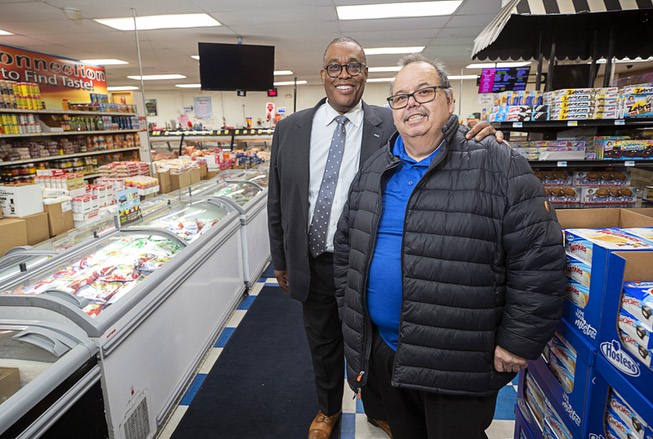Historic Westside grocery eyes move, expansion in 2023 with help of $1 million grant
Historic Westside grocery eyes move, expansion in 2023 with help of $1 million grant
December 15, 2022
Las Vegas Sun News
By Grace Da Rocha
Las Vegas City Councilman Cedric Crear and his family have frequented Mario’s Westside Market, the independent grocery store on North Martin Luther King Boulevard, since it opened in 1997.
Some of the stops are for a week’s worth of supplies. Others are for ingredients needed by Keiba, his wife, a Louisiana native, for the traditional Creole dishes she cooks. And some days, he looks to quickly stop in on the way home only to run into a childhood friend and spend time catching up.
It’s a similar narrative for others in the tight-knit Historic Westside, the neighborhood north of U.S. 95, south of Carey Avenue and Lake Mead Boulevard, east of Rancho Drive and west of Interstate 15.
“When you talk about Mario’s, I think it goes hand-in-hand when talking about the community,” Crear said. “The people that come here — our family — they’re regular people that you see two, three times a week (who) are just passing through, and it’s always great.”
Mario’s Westside Market will be expanding after receiving a $1 million grant from Las Vegas as part of the city’s use of $130.6 million in American Rescue Plan funding. The federal government is requiring the city to spend the money by Dec. 31, 2024, and to support issues and groups most affected by the COVID-19 pandemic.
The city set aside 20% of the funds for business assistance proposals like the market expansion. It received $2.2 billion in requests, officials said.
The market, which sits amid what is considered a “food desert,” is expanding by moving into a neighboring 14,000-square-foot building that was formerly a drug store. A deli and hot foods section will be joined by an expanded produce section with organic products, a bakery and space for over-the-counter medicines.
“We’ll be able to add lots more stuff that the neighborhood needs — a fresh bakery,” co-owner Mario Berlanga said.
With a new partnership with Associated Foods Stores, a retailers cooperative that supplies independent markets, Berlanga said he planned to expand the selection of foods offered at Mario’s.
Construction associated with the move is slated to start in February and finish in June.
Almost 15% of residents in Clark County are food insecure, in other words, households with limited or uncertain access to adequate food. In the 89106 ZIP code, which includes Mario’s Westside Market, 19.2% of the population is food insecure, according to Three Square Food Bank’s 2022 Map the Meal Gap study.
Crear said the expansion of Mario’s was part of the city’s Historic Urban Neighborhood Design Redevelopment (HUNDRED) Plan to help revitalize the Historic Westside and address issues like food insecurity.
Shopping centers anchored by big-chain markets have shuttered over the years in the Historic Westside. That’s forced some residents to shop at the Smith’s Food and Drug on Rancho Drive and Charleston Boulevard, or the Albertsons on Craig Road in North Las Vegas. That’s not practical for many residents of the neighborhood lacking transportation, Crear stresses.
“(People) in this community are able to get here and not have to hop on a bus and ride 30, 45 minutes” to get groceries, Crear said. “They can walk right up here to get what they need (and) go back home, so it’s everything to the community.”
The expansion of the market is important to show residents that the city is invested in making their lives better, Crear said. A Vons previously operated in Nucleus Plaza on West Owens Avenue but was closed in 2004. It was replaced by a Fresh and Easy, but Crear jokingly says the food wasn’t fresh and the prices weren’t easy.
Investing in Mario’s, he said, is important because the store has long been a contributing member of the Historic Westside community. Its prices are reasonable, he said, and owners give back to the neighborhood, such as sponsoring a Little League team.
“You can invest in a proven commodity in our community, and what better way to make an investment than in the people who are serving our community,” he said.
The HUNDRED Plan is pouring millions into the neighborhood to identify the opportunities to link with the past and create a familiar bridge to the future.
The plan was created in 2016 and adopted by the city, which has provided funds and helped identify physical locations for projects to spotlight the community’s identity. The project also includes: the Reimagined James Gay III Park, installation of an African American Museum and Cultural Center and Historic Westside Mural.
Some residents, Crear said, “have a lack of trust in government (because) many times over the course of decades they say ‘we’re gonna do this,’ then nothing ever happens … so we’re changing that,” Crear said.
The store sees about 1,600 to 1,700 customers a day, Berlanga said, but he expects that number to almost double with the move. Plans call for the current building eventually to give way for additional parking.
Still, Berlanga wants to preserve the store’s communal appeal, he said.
“Everybody knows each other by name … They know you or your family member, and that’s some of the stuff that makes us work,” Berlanga said.

